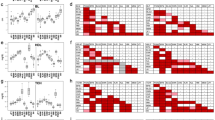Abstract
Traditional fine-mapping approaches in mouse genetics that go from a linkage region to a candidate gene are very costly and time consuming. Shared ancestry regions, along with the combination of genetics and genomics approaches, provide a powerful tool to shorten the time and effort required to identify a causative gene. In this article we present a novel methodology that predicts IBD (identical by descent) regions between pairs of inbred strains using single nucleotide polymorphism (SNP) maps. We have validated this approach by comparing the IBD regions, estimated using different algorithms, to the results derived using the sequence information in the strains present in the Celera Mouse Database. We showed that based on the current publicly available SNP genotypes, large IBD regions (>1 Mb) can be identified successfully. By assembling a list of 21,514 SNPs in 61 common inbred strains, we inferred IBD regions between all pairs of strains and confirmed, for the first time, that existing quantitative trait genes (QTG) and susceptibility genes all lie outside of IBD regions. We also illustrated how knowledge of IBD structures can be applied to strain selection for future crosses. We have made our results available for data mining and download through a public website ( http://www.mouseibd.florida.scripps.edu).






Similar content being viewed by others
References
Adams DJ, Dermitzakis ET, Cox T, Smith J, Davies R, et al. (2005) Complex haplotypes, copy number polymorphisms and coding variation in two recently divergent mouse strains. Nat Genet 37:532–536
Bachmanov AA, Li X, Reed DR, Ohmen JD, Li S, et al. (2001) Positional cloning of the mouse saccharin preference (Sac) locus. Chem Senses 26:925–933
Cervino AC, Li G, Edwards S, Zhu J, Laurie C, et al. (2005) Integrating QTL and high-density SNP analyses in mice to identify Insig2 as a susceptibility gene for plasma cholesterol levels. Genomics 86:505–517
Davis RC, Schadt EE, Smith DJ, Hsieh EW, Cervino AC, et al. (2005) A genome-wide set of congenic mouse strains derived from DBA/2J on a C57BL/6J background. Genomics 86:259–270
Denny P, Lord CJ, Hill NJ, Goy JV, Levy ER, et al. (1997) Mapping of the IDDM locus Idd3 to a 0.35-cM interval containing the interleukin-2 gene. Diabetes 46:695–700
Doss S, Schadt EE, Drake TA, Lusis AJ (2005) Cis-acting expression quantitative trait loci in mice. Genome Res 15:681–691
Farahani P, Fisler JS, Wong H, Diament AL, Yi N, et al. (2004) Reciprocal hemizygosity analysis of mouse hepatic lipase reveals influence on obesity. Obes Res 12:292–305
Ferraro TN, Golden GT, Smith GG, Martin JF, Lohoff FW, et al. (2004) Fine mapping of a seizure susceptibility locus on mouse Chromosome 1: nomination of Kcnj10 as a causative gene. Mamm Genome 15:239–251
Flint J, Valdar W, Shifman S, Mott R (2005) Strategies for mapping and cloning quantitative trait genes in rodents. Nat Rev Genet 6:271–286
Frazer KA, Wade CM, Hinds DA, Patil N, Cox DR, et al. (2004) Segmental phylogenetic relationships of inbred mouse strains revealed by fine-scale analysis of sequence variation across 4.6 mb of mouse genome. Genome Res 14:1493–1500
Grupe A, Germer S, Usuka J, Aud D, Belknap JK, et al. (2001) In silico mapping of complex disease-related traits in mice. Science 292:1915–1918
Hillebrandt S, Wasmuth HE, Weiskirchen R, Hellerbrand C, Keppeler H, et al. (2005) Complement factor 5 is a quantitative trait gene that modifies liver fibrogenesis in mice and humans. Nat Genet 37:835–843
Ikeda A, Zheng QY, Zuberi AR, Johnson KR, Naggert JK, et al. (2002) Microtubule-associated protein 1A is a modifier of tubby hearing (moth1). Nat Genet 30:401–405
Karp CL, Grupe A, Schadt E, Ewart SL, Keane–Moore M, et al. (2000) Identification of complement factor 5 as a susceptibility locus for experimental allergic asthma. Nat Immunol 1:221–226
Liao G, Wang J, Guo J, Allard J, Cheng J, et al. (2004) In silico genetics: identification of a functional element regulating H2-Ealpha gene expression. Science 306:690–695
Mural RJ, Adams MD, Myers EW, Smith HO, Miklos GL, et al. (2002) A comparison of whole-genome shotgun-derived mouse chromosome 16 and the human genome. Science 296:1661–1671
Pletcher MT, McClurg P, Batalov S, Su AI, Barnes SW, et al. (2004) Use of a dense single nucleotide polymorphism map for in silico mapping in the mouse. PLoS Biol 2:e393
Shifman S, Darvasi A (2005) Mouse inbred strain sequence information and yin–yang crosses for quantitative trait locus fine mapping. Genetics 169:849–854
Shirley RL, Walter NA, Reilly MT, Fehr C, Buck KJ (2004) Mpdz is a quantitative trait gene for drug withdrawal seizures. Nat Neurosci 7:699–700
Wade CM, Kulbokas EJ 3rd, Kirby AW, Zody MC, Mullikin JC, et al. (2002) The mosaic structure of variation in the laboratory mouse genome. Nature 420, 574–578
Wang X, Paigen B (2002) Quantitative trait loci and candidate genes regulating HDL cholesterol: a murine chromosome map. Arterioscler Thromb Vasc Biol 22:1390–1401
Wiltshire T, Pletcher M, Cole SE, Villanueva M, Birren B, et al. (1999) Perfect conserved linkage across the entire mouse chromosome 10 region homologous to human chromosome 21. Genome Res 9:1214–1222
Wiltshire T, Pletcher MT, Batalov S, Barnes SW, Tarantino LM, et al. (2003) Genome-wide single-nucleotide polymorphism analysis defines haplotype patterns in mouse. Proc Natl Acad Sci USA 100:3380–3385
Yalcin B, Fullerton J, Miller S, Keays DA, Brady S, et al. (2004) Unexpected complexity in the haplotypes of commonly used inbred strains of laboratory mice. Proc Natl Acad Sci USA 101:9734–9739
Acknowledgments
The authors thank Ariel Darvasi for critical reading of the manuscript. This work was supported by the Florida Funding Corporation.
Author information
Authors and Affiliations
Corresponding author
Electronic Supplementary Material
Rights and permissions
About this article
Cite this article
Cervino, A.C., Gosink, M., Fallahi, M. et al. A comprehensive mouse IBD database for the efficient localization of quantitative trait loci. Mamm Genome 17, 565–574 (2006). https://doi.org/10.1007/s00335-005-0170-4
Received:
Accepted:
Published:
Issue Date:
DOI: https://doi.org/10.1007/s00335-005-0170-4




